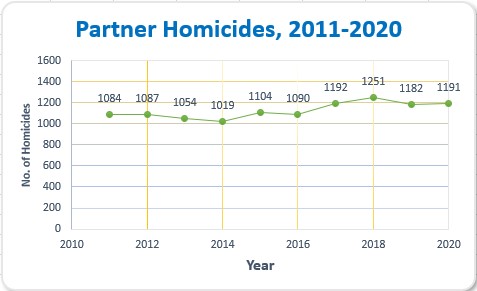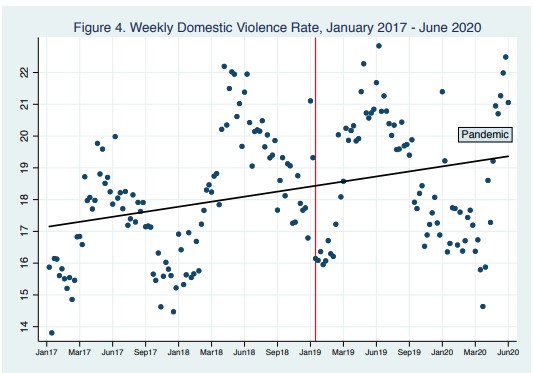The Great Coronavirus Abuse Hoax
- Editorials:
On March 23, 2020 the National Task Force to End Sexual and Domestic Violence issued an Alert with this startling coronavirus claim: “Survivors of domestic violence and sexual assault are facing extreme danger and risk.” Likewise, UN Women declared a “shadow pandemic of violence against women and girls” would result from lockdowns across the world. These alerts did not provide any evidence to support their claims. Subsequently, a wave of media accounts predicted an imminent “spike” and “spurt” of abuse, often featuring heart-rending — but unsubstantiated — anecdotes.
But the predicted catastrophe never happened. Numerous independent analyses of hotline calls, police calls for service, and crime statistics, both in the United States and abroad, concluded that overall, there was no increase in domestic violence or sexual assault, and some locales saw a decrease:
Hotline Calls
The National Domestic Violence Hotline reports on the number of answered calls, chats, and texts received each year since 1996. The graph from the most recent report reveals the number of answered inquiries in 2020 was 363,000, which is the same number as in 2018. Clearly, there was no “spike” or “surge” in the number of abuse calls during the COVID pandemic:

Police Calls for Service
A “call for service” is a request that a police officer be dispatched to a home or other location to provide assistance.
A. An analysis of “domestic violence/family dispute” calls by criminologist Matthew Ashby in seven cities reported that overall, there was a 2% decrease in domestic violence/family dispute calls.
B. The Marshall Project found declines in domestic violence calls in Chicago, IL, Austin, TX, and Chandler, AZ, ranging from 13% to 23% (shaded areas on the right indicate the period when shelter-in-place policies were in effect):

Commission of Crimes: Domestic Violence, Rapes, and Homicides
A. Domestic violence: The National Commission on COVID-19 and Criminal Justice concluded, based on reports from 11 cities, that “Domestic violence did not increase in the first quarter of 2021 over the first quarter of 2020.” A second analysis of arrests of juveniles in Florida for domestic violence reported an “astonishing” 44% decline from April to June 2020, compared to April to June 2019.
B. Rapes: The FBI reports, “When compared with the estimates from 2019, the estimated… volume of rape (revised definition) offenses decreased 12.0%,” from 43.6/100,000 persons in 2019 to 38.4/100,000 in 2020:

C. Homicides: The FBI Uniform Crime Reporting Program provides information on various crimes, as well supplemental information about the circumstances surrounding the offense, such as the relationship of the offender to the victim. Even though the overall number of murders increased by 29% in 2020, the number of homicides committed by spouses, girlfriends, and boyfriends remained steady in 2020:

International
A. Similar conclusions have been reached in Australia:
- New South Wales: The Bureau of Crime Statistics and Research found “no evidence of an increase in domestic violence since social distancing was implemented in response to the COVID-19 pandemic.”
- Queensland: Researchers found no increase in domestic violence crimes.
- Victoria: “Since stage 3 restrictions were reintroduced in Victoria in July, Victoria Police have reported a slight decrease in family violence reports around the state.”
B. Reports from the following countries revealed no increase in domestic violence as a result of COVID stay-at-home policies: Albania, Austria, Canada, India, Netherlands, Russia, Spain, and Tasmania.
How Did this Happen?
The most likely explanation for the downward trend in many areas was identified by the Family Life Survey of the Center for the Study of Elections and Democracy, which found that coping with the COVID threat has served to strengthen family relationships. 56% of survey respondents agreed that experiencing the pandemic “Has made me appreciate my partner more,” and 47% agreed that the coronavirus, “Has deepened my commitment to my relationship:”

Despite these well-documented findings, countless media accounts have continued to promote the COVID-abuse myth, sounding the alarm of an imminent “spike” in domestic violence and sexual assault. Tellingly, these articles never highlighted the fact that each year there are more male victims than female victims, according to the CDC. Even lawmakers were fooled by the Hoax.
One of the reasons for the false claims was a failure to acknowledge that domestic violence incidents follow a cyclical pattern, with the number of cases rising in the Spring and declining in the Fall. If this pattern is not recognized, increases due to seasonal changes could be incorrectly attributed to coronavirus stay-at-home policies:

The claim that “Survivors of domestic violence and sexual assault are facing extreme danger and risk” is provably false, a prime example of the falsehoods and lies that characterize many domestic violence programs. Commentator Corrine Barraclough concludes, “The myth that domestic violence is surging in lockdown will become one of the biggest lies the gendered narrative leans on for additional funding.”


